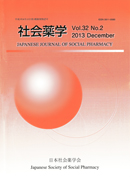Volume 32, Issue 2
Displaying 1-10 of 10 articles from this issue
- |<
- <
- 1
- >
- >|
Preface
-
2013 Volume 32 Issue 2 Pages 1
Published: December 10, 2013
Released on J-STAGE: June 26, 2015
Download PDF (207K)
Original Articles
-
2013 Volume 32 Issue 2 Pages 2-7
Published: December 10, 2013
Released on J-STAGE: June 26, 2015
Download PDF (241K) -
2013 Volume 32 Issue 2 Pages 8-17
Published: December 10, 2013
Released on J-STAGE: June 26, 2015
Download PDF (1421K) -
2013 Volume 32 Issue 2 Pages 18-26
Published: December 10, 2013
Released on J-STAGE: June 25, 2015
Download PDF (1606K) -
2013 Volume 32 Issue 2 Pages 27-32
Published: December 10, 2013
Released on J-STAGE: June 26, 2015
Download PDF (1061K)
Research Notes
-
2013 Volume 32 Issue 2 Pages 33-42
Published: December 10, 2013
Released on J-STAGE: June 26, 2015
Download PDF (761K) -
2013 Volume 32 Issue 2 Pages 43-47
Published: December 10, 2013
Released on J-STAGE: June 26, 2015
Download PDF (798K)
Reports
-
2013 Volume 32 Issue 2 Pages 48-53
Published: December 10, 2013
Released on J-STAGE: June 26, 2015
Download PDF (541K)
Reports
-
2013 Volume 32 Issue 2 Pages 54-61
Published: December 10, 2013
Released on J-STAGE: June 26, 2015
Download PDF (1006K)
Column
-
2013 Volume 32 Issue 2 Pages 62-63
Published: December 10, 2013
Released on J-STAGE: June 26, 2015
Download PDF (417K)
- |<
- <
- 1
- >
- >|
